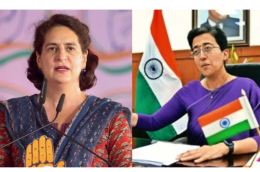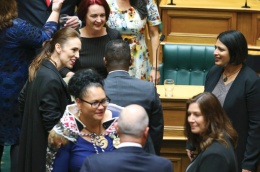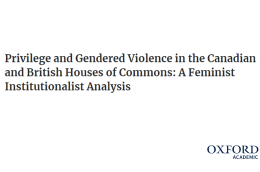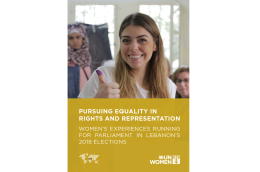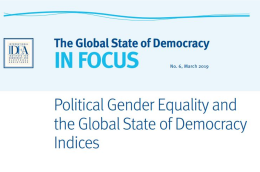Parliaments & Representatives
Main navigation
Among the most pressing issues we face today is the persistent harassment of women in politics and government — a problem that undermines both the integrity of public service and the diversity of leadership our communities desperately need.
Across the nation, women in the political sphere face heightened scrutiny, verbal attacks, and even threats of violence simply for doing their jobs. Indiana is no exception. From social media vitriol aimed at female candidates to inappropriate behavior within government offices, harassment in its many forms continues to discourage talented women from entering and remaining in public service. If we want Indiana to thrive, we cannot afford to allow this environment to persist.
The statistics are alarming. Studies show that women in politics are disproportionately targeted by online abuse compared to their male counterparts. Harassment often focuses on gender, appearance, or personal life, rather than policy or qualifications, creating an additional mental and emotional burden for female leaders. For many, these attacks don’t stop at words. A 2022 survey by the Center for American Women and Politics found that 25% of women in public office reported threats or acts of violence.
Read here the full article published by the Indiana Capital Chronicle on 31 January 2025.
Image by Indiana Capital Chronicle
British MP Jess Phillips describing the online attacks she has received from Elon Musk in recent days as “very, very, very tiring” will have struck a chord with many women. Powerful men trying to silence women happens so often that it rarely makes news.
But Musk’s comments calling Phillips, who currently serves as safeguarding minister, a “rape genocide apologist” and saying she should be in prison has brought the online abuse of women politicians, and the danger that it presents, back into sharp focus.
Never before has an overseas tech mogul (who happens to be the world’s richest man) targeted government ministers and MPs for personal abuse like this. The accusations have encouraged others to attack Phillips, posing a very real threat to her safety. Phillips has reportedly been assigned close protection officers and been told not to go out in public alone.
Read here the full article published by The Conversation on 10 January 2025.
Image by The Conversation
Some reports suggest that female politicians face such behaviour more often than their male counterparts and it has even been reported that female politicians have begun to view toxic messages and harassment as just a part of the job.
This kind of hostility can deter women from remaining in politics and discourage those who haven't run for office from considering it. Politicians, including former UK Culture Secretary Nicky Morgan and former MPs Heidi Allen and Dehenna Davison have cited abuse and harassment as factors in their decisions to step down.
Such toxic behavior could ultimately hinder women's participation in public debate and democratic engagement overall.
In a new comparative study co-authored by Professor Anne Rasmussen, of King’s College London, and Dr Gregory Eady, from the University of Copenhagen, and published in the the American Political Science Review, more light is shed on the issue of toxicity in politics.
The researchers found that abuse directed at women in politics is viewed as more severe than those aimed at men, even if the nature and frequency of abuse received is similar. The study also explains why this occurs, showing that attacks on women are more likely to be perceived as motivated by misogyny and a desire to exclude women from public office, compared to abuse directed at men. In contrast, attacks on women are less likely than those on men to be seen as driven by other factors, such as policy disagreements.
Read here the full article published by King's College London on 22 January 2025.
Image by King's College London
Women have emerged as a significant vote bank in the last few elections in India. Despite that, political speeches of elected representatives or contestants across parties have consistently displayed an aversion to or prejudice against women. Comments have ranged from “How much are you being sold for”, “Worse than a prostitute”, “Kitni jagah leti hai woh, unka to chunao chinh hathi hai (She takes so much space, even her party symbol is that of an elephant)”, “dented-painted women protestors”, “the length of cigarettes she smokes and who she lives with”, “worse than a woman”, “temptress”, “enthral people with ghungroos and thumkas”, to “top khule nachleo vote debo na (Won’t vote for her even if she dances with her top off)”.
The recent remarks by BJP leader Ramesh Bidhuri on Priyanka Gandhi’s “cheeks” and Atishi’s “change of father” add to the miserable trend. Even holding an office as high as the Chief Minister’s does not serve as a deterrent to misogynist remarks attaching derogatory and sexualised meanings concerning the body, character, conduct, and profession.
Read here the full article published by The Indian Express on 14 January 2025.
Image by The Indian Express
In Pakistan’s last general election, in February 2024, Suriya Bibi became the first woman to be elected to the provincial assembly of Khyber Pakhtunkhwah from Chitral, on the Afghanistan–Pakistan border. She contested the election as an independent candidate with no prior history of contesting elections, though the Pakistan Tehreek-i-Insaaf (PTI), led by the former prime minister Imran Khan, backed her candidacy. She won with almost 19,000 votes, defeating a male candidate of the Jamiat Ulema-e-Islam-Fazl (JUI-F), a party representing the Deobandi brand of Islam, known for its ultra-conservative views on women’s participation in public life. After the election, Suriya Bibi also became the deputy speaker of the provincial assembly.
Read here the full article published by Himal Southasian on 11 January 2025.
Image by the Himal Southasian
From the United States to Italy, Britain, and Pakistan, female politicians are increasingly becoming victims of AI-generated deepfake pornography or sexualised images, in a troubling trend that researchers say threatens women’s participation in public life.
An online boom in non-consensual deepfakes is outpacing efforts to regulate the technology globally, experts say, with a proliferation of cheap artificial intelligence tools including photo apps digitally undressing women.
The intimate imagery is often weaponised to tarnish the reputation of women in the public sphere, jeopardising their careers, undermining public trust, and threatening national security by creating conditions for blackmail or harassment, researchers say.
In the United States, the American Sunlight Project, a disinformation research group, identified more than 35,000 instances of deepfake content depicting 26 members of Congress — 25 of them women — across pornographic sites.
Read here the full article published by The Hindu on 7 January 2025.
Image by The Hindu



